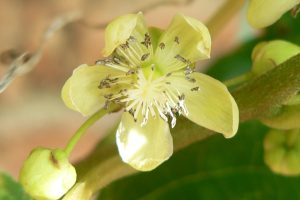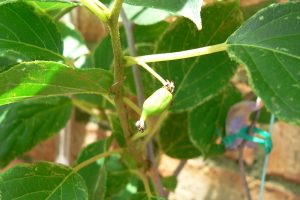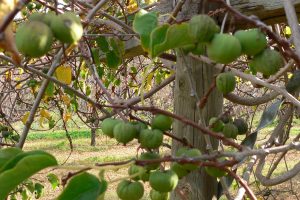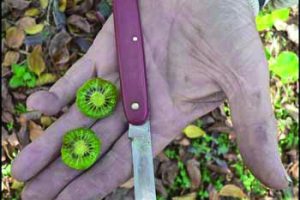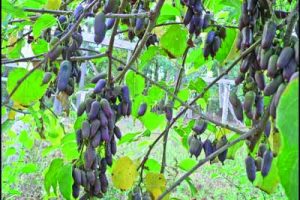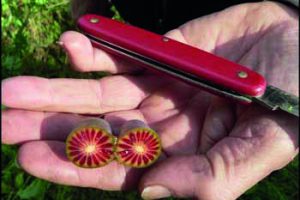Actinidia arguta var. arguta
Kiwiberry, baby kiwi, hardy kiwi
Origin
North eastern Asia, mainly China, Japan and Korea. It is now grown in several countries worldwide with some small commercial plantations recently established.
Climate
It is a temperate zone species and grows up to altitudes of 3000m. Mature dormant plants can withstand winter temperatures down to -30°C (thus the descriptor ‘hardy’) but when young they are far less tolerant and need protection. Such extreme cold weather is not necessary to satisfy their chill requirements. They do best in humid environments with regular and copious watering, particularly during flowering and fruiting.
Plant Description
Deciduous and vigorous long-lived vines that in the wild unpruned state can climb 30m into the canopy of surrounding trees. New growth obtains support by twining around supports rather than by tendrils or spines. Early branch growth is brown and then becomes grey with age. The simple, alternate, ovate leaves with serrate margins are shiny dark green, 6-12cm long and have long glabrous green or sometimes red petioles. Autumn leaves turn an eye-catching yellow before abscission. The species has 29 chromosomes; wild species are diploid, most named cvs are tetraploid and Issai is heptaploid.
Relatives
Kiwiberry is a member of the Actinidiaceae family which has more than 70 genera, all of which are perennial vines or scramblers, dioecious and produce berry fruit. Other fruiting species in the genus include kiwifruit, Arctic beauty kiwi, silver vine and velvet vine.
Soils
These must be well-drained, with an acid pH 5-6.5 preferred; alkaline soils will result in nutritional problems. They do not tolerate saline soils or water.
Propogation
Cuttings and grafting are really the only way to proceed, short of simply buying nursery plants; seedlings are mainly for breeding. Despite possible ploidy incompatibility problems, kiwiberry can sometimes be successfully grafted onto kiwifruit as rootstock (eg cv Bruno).
Cultivars
There are many cvs elsewhere, eg the females Geneva (US), Rogow (Polish), Jumbo (italian), Mitsuko and Nagano (Japanese) and male Awaji (Japanese), but the Japanese cv Issai may be the only one you can source here. The latter has the advantage of being the only kiwiberry variety that is reasonably self-fertile. It is also precocious with cropping as fast as 1-2 yrs from planting out, but it’s not as vigorous a plant as the others; this could actually be another advantage if space is limited. There is a female hybrid cv from NZ called Ken’s Red where fruit skin turns red on ripening. As with its more established and successful cousin the kiwifruit, the New Zealanders are playing a major role in further development and commercialisation.
Flowering and Pollination
Axillary inflorescences are cymes with 1-6 individual creamy white flowers 1-2cm wide. Sepals and petals number 4-6 each. The numerous black or dark purple stamens are 1.5-3mm long, the glabrous ovary is bottle-shaped, 6-7mm long, and the many styles 3-4mm long. Although flowers are morphologically hermaphrodite, they are functionally dioecious. Pollen from male cvs remains viable for 2-4 days and female stigmas are receptive for 9-10 days. Bees are not strongly attracted to flowers, but they are the main pollinators together with other insects and wind. All cvs need a variable amount of chilling for flowering. The hermaphrodite Issai achieves 30% fruit set with self-pollination and double this with cross-pollination. Pollen from this heptaploid is sterile but pollination is still necessary to stimulate fruit development parthenocarpically if no male plants are available. The resulting fruit have seed counts many times lower than those that have been cross-pollinated.
Cultivation
Full sun is best but part shade is tolerated. Mature vines will need 3-4 m spacing. In their first year fertilization should be minimal as they are susceptible to fertilizer burn. However once established, these vigorous vines require regular annual fertilizing, increasing with size. Strong support structures should be provided and mulching assists maintenance of moisture throughout the year.
Wind Tolerance
The whole vine tethered to a trellis provides some support during strong wind, but loose fruiting laterals may still be shaken, resulting in unwanted damage to flowers and fruit.
Pruning
Pruning is necessary to shorten the juvenility stage and maximise yield. The process is similar to that employed with cane-pruned grapes. In the early years, a single stem is trained up a vertical support to a cross-wire or trellis, then permanent laterals (cordons) established. These are then cut back to 8-10 buds when dormant and eventually allowed to grow 2-4m long. Fruiting laterals will grow perpendicularly from these in the following season and fruit clusters will form from growth towards their base. Each year a base non-fruiting lateral (pruned back to 8-10 buds) is kept and will be the source of fruiting laterals in the following year; those that have already fruited are removed. Growth from the trunk should always be removed. Within the cordons and fruiting laterals, pruning should be such that light interception is maximised. Fruiting laterals on the permanent cordons less than 15-20cm apart should also be removed to enhance fruit size. Kiwiberry vines are pruned hard, but don’t overdo it as this will result in dominant vegetative rather than reproductive growth.
The Fruit
The mature glabrous sub-globose berry is 1.5-2.5cm long, weighs 5-15g, usually with greenish flesh but also purple-red and has numerous black edible seeds. Jumbo can weigh up to 30g. It has higher general nutritional value (antioxidants etc) than kiwifruit, assisted by being able to eat the skin, which is where many fruit have most of their valuable nutrients. Some people are allergic to fresh Actinidia fruit.
Fruit Production and Harvesting
The juvenility period for unpruned plants in the wild is 6-7 years whereas in cultivation and with appropriate pruning this reduces to 3-4. Fruits reach 80% of their final size within 6 weeks of pollination and can be harvested in 14-16, usually around March-May. They ripen unevenly on the vine and should be harvested by clipping off whole clusters when the first few fruit are soft. Picking at this mature firm stage when Brix averages about 14% still allows the fruit to ripen (as with bananas) up to Brix levels of 25%, but gives better storage properties and less bruising. An average well-managed vine produces 10-20kg of fruit, some cvs even more. There is a tendency for alternate bearing that can be countered by pruning and fruit thinning.
Fruit Uses
The whole fruit is almost always eaten fresh without the need for peeling – they are delicious and sweeter than kiwifruit. If sliced transversely, they make an attractive decorative touch to fruit salads with their central white core surrounded by small black seeds interspersed between the centrally-emanating rays. Drying extends their lifetime well beyond that in the fresh state and the flavour is excellent; preparation may simply be cutting them in half to speed up moisture loss. They can also be included in smoothies, jams, jellies and other processed products. Storage at 2°C is 2-3 weeks when fruit are mature firm and 1 week when soft ripe.
Pests and Diseases
Generally minimal, but they are susceptible to Phytophthora infection causing root or crown rot. Other problems occasionally reported include: botrytis rot, sclerotinia blight, root knot nematodes, spider mites, leaf rollers and thrips.
Comments
You can grow kiwiberries in the Perth region, provided you consider the chilling requirement, they get sufficient water and are pruned properly. Issai has many favourable attributes for growing here, but if you have the space and can obtain a different cv male pollinator, fruit size and yield will be increased. If growing for fruit, you’ll need to prune annually in both winter and summer. They are vigorous plants and need copious watering, both while being established and when carrying a crop. Cross breeding between kiwiberry and kiwifruit has now been successfully undertaken and trials are underway to select the best clones before release. These hybrids will bring increased sweetness and cold tolerance plus no-fuzz edible skin to the established kiwifruit brand. A wider climatic range worldwide will then be possible for commercial production and the example of nectarines and peaches illustrates the importance consumers place on non-furry fruit skins.
